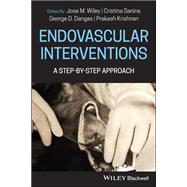A practical and systematic approach to current endovascular surgical techniques
An increasingly popular alternative to open vascular surgery, endovascular intervention offers many advantages, including reduced patient discomfort, smaller incisions, shorter recovery time, and decreased risk of adverse complications. Practitioners and trainees alike require expert guidance on current technologies and up-to-date techniques. Endovascular Interventions provides clinicians with an easy-to-follow guide for minimally invasive treatment of vascular disease. This invaluable resource delivers concise and accurate instructions on a wide range of endovascular interventions, including aorta, renal and mesenteric interventions, lower extremity interventions, venous interventions, and supra-aortic interventions in high-risk patients.
Sequential phases of skill development broaden the reader’s abilities as they progress through each chapter, supplying step-by-step instructions on when each procedure should be used and how it can be safely and effectively performed. This book offers a complete reference to essential techniques and procedures, suitable for both novice and experienced vascular surgeons, cardiologists, and radiologists. Endovascular Interventions also:
- Reinforces comprehension of each procedure with templated chapters, equipment lists and boxed key learning points
- Provides full-color clinical images and detailed illustrations to demonstrate surgical procedures
- Presents authoritative coverage of modern endovascular technologies and techniques
- Written by a team of respected experts and practicing surgeons from internationally recognized hospitals and universities
Suitable for varying skill levels, Endovascular Interventions is a precise, accessible instruction manual for safe and effective endovascular intervention, helping practicing clinicians sharpen their existing abilities and keep pace with the latest surgical technologies while instructing trainees on this innovative approach to vascular surgery.








